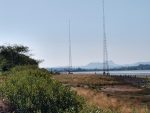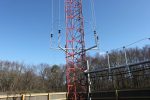Or, it could also be phrased “A solution that causes more problems.” Radio World, once again, has a good article on the consequences of increasing IBOC power of the FM hybrid system. Especially telling is figure 24, a fuzzy 400 Hz sine wave showing how much distortion is added to the analog signal by a mere 4% HD signal. I’d be especially interested to see the results of the full 10% now allowed.
Naturally, HD proponents will cry “But this is only temporary! Wait until the transition to all digital!”
Bunk.
If HD radios were indeed flying off the shelves as iBiquity claims, and if the public expressed interest, okay, maybe. Clearly, that is not the case. The only thing that HD radio is doing is creating more interference. Period. More interference to the parent station and more interference to the adjacent channels all for an audience that does not exist. Another way to put it: NOBODY IS LISTENING. One of the stations that I service had a Harris Deathstar go offline for four days. NOT ONE PHONE CALL, NOBODY CARES!
The public did not perceive a technical problem with analog FM broadcasting. Of course, that can always change as the band gets filled with interference.
Let’s see where FM IBOC stands:
- Rolled out with 1% digital power vs analog carrier, the system was found to lack building penetration and generally performed poorly in mobile listening environments (NPR labs study, Nov 24, 2009)
- FCC allows up to 10% digital power vs analog carrier to overcome these problems, a few stations implement some type of power increase
- This shows that self-interference is the largest problem IBOC needs to fix, one that is un-fixable due to the laws of physics
- The public yawns, turns on their iPod
IBOC is a failure, both in AM and FM bands.
We are watching the self-destruction of radio broadcasting in the US.






One statement that made me laugh, but happens to be the truth; “The public yawns, turns on their ipod”. While the media elites try to out do Steve Jobs, Bill Gates, or Barack Obumma with new spending mechanisms creating new radio gizmos, the public is happier seeking its own music sources.
Luckily, only about 150 FM-HD stations have expesssed any interest in a power increase. Last checked only 86 had raised power, and only 3 to full -10db. Poor Peter Doyle at the FCC is disappointed! LOL! A scam from the start, enabled by the FCC. There are no guarantees that a power increase would help much with HD Radio’s many problems, anyway. IBOC has pretty much destroyed the AM band, and it could do the same to FM. Struble and his NRSC/NAB investors are only looking for an iBiquity IPO, and are not one bit concerned with the slow destruction of our airwaves.
Well, short of the FCC mandating HD Radio, I don’t see it going anywhere; it is too expensive, there is no ROI, there is no public interest in it.
@Paul: It would take an Act of Congress to mandate IBOC, as it did with the digital TV transition. There are no reclaimation needs for analog terrestrial radio, as there were for the olg analog TV spectrum. A mandate would put many of the smaller broadcasters out of businees, by forcing them to pay for expensive equitment, and to pay royalties to iBiquity which might even be illegal. I’m sure it would be taken to a court of appeals. I still don’t belive that even a mandate wold be successful, as we have seen the failure of DAB in the UK.
With the current economy, “stimulus” spending, and citizen anger ready to “Throw the Bums Out”, I doubt there would be a “Chinaman’s Chance” of a DAB mandate in the USA. Radio engineering has been turned upside down with many of these afterthought grandiose plans.
Re: “The public did not perceive a technical problem with analog FM broadcasting. Of course, that can always change as the band gets filled with interference.”
At the risk of sounding cynical, maybe that’s the plan: ramp up power on the HD signal, thereby degrading the quality of the analog signal, and then use listener frustrations with the degraded quality of the analog signal as an argument for transitioning to purely digital broadcasting.
@Oscar, I don’t think that is cynical at all…
@Oscar: I’m convinced that is part of the plan. To slowly degrade analog, in order to force digital adoption. But it is not working, as HD radio sales are pretty much nonexistent. It will only serve to drive analog listeners elsewhere. iBiquity is trying to localize the coverage of radio stations, by jamming adjacent-channel stations, forcing listeners onto the local HD Radio stations. In the Bay Area, listeners have complained about losing up to 17 analog FM stations to IBOC.